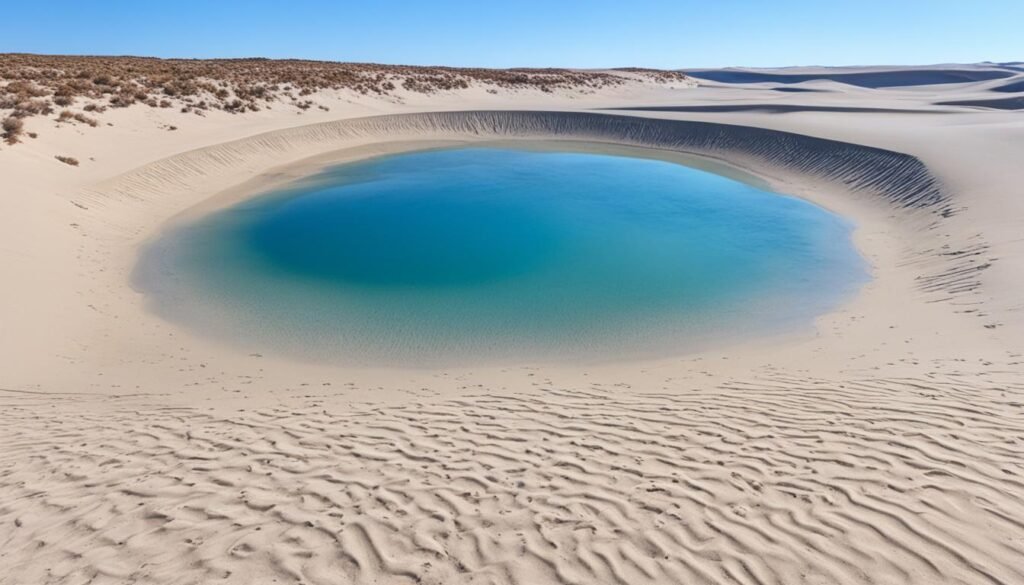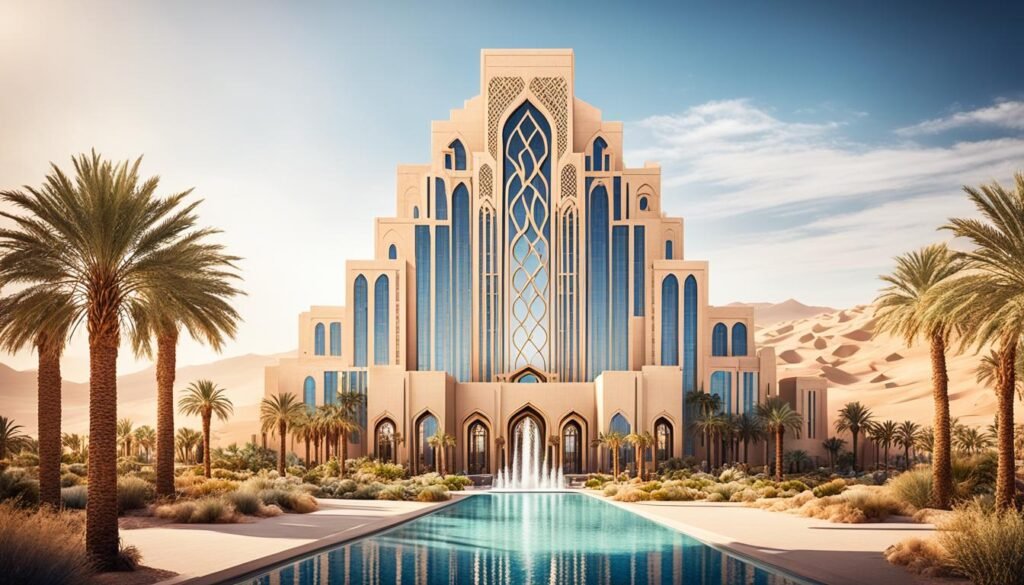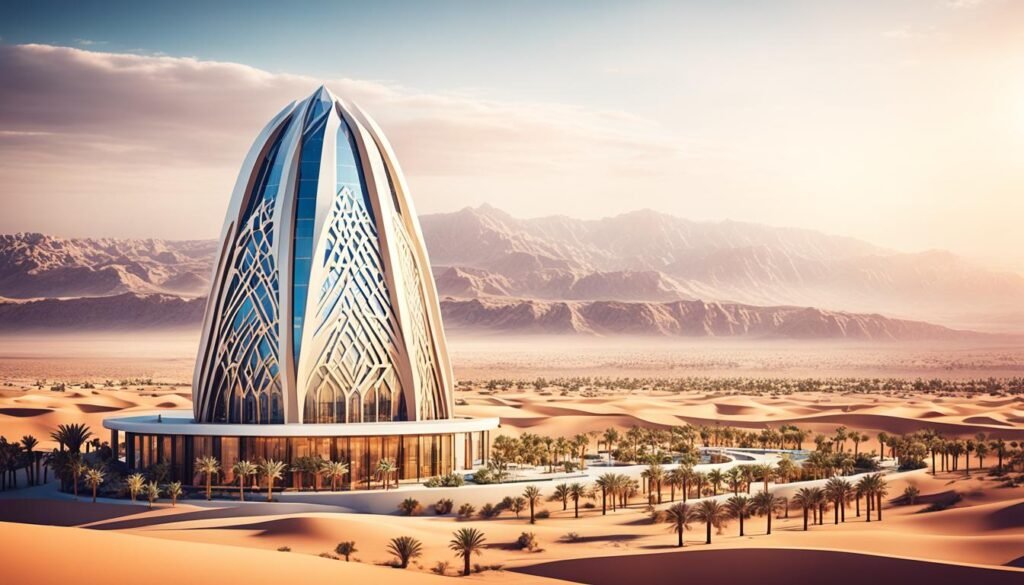Remarkably, Dubai’s urban landscape showcases an architectural marvel that seamlessly blends modern aesthetics with the region’s arid climate. In a city where the temperature can reach scorching heights, the desert architecture of Dubai has become a testament to the ingenuity of designers and engineers who have risen to the challenge of creating sustainable, energy-efficient structures that not only thrive in the Middle Eastern environment but also push the boundaries of architectural innovation.
This article will delve into the captivating world of desert architecture in Dubai, UAE, exploring the iconic mid-century modern buildings, the origins of the UAE’s modern architectural evolution, and the innovative approaches that have transformed the city’s skyline. From towering skyscrapers to futuristic projects like the Palm Islands, Dubai’s architecture showcases a remarkable blend of traditional Arabic influences and cutting-edge design solutions, all while navigating the constraints of the arid climate.
Key Takeaways
- Dubai’s desert architecture seamlessly blends modern design with the region’s arid climate.
- Iconic mid-century modern buildings and the origins of the UAE’s modern architecture are explored.
- Innovative approaches to designing for the desert environment, including sustainable and energy-efficient strategies.
- Architectural marvels in Dubai, such as towering skyscrapers and futuristic projects like the Palm Islands.
- A remarkable blend of traditional Arabic influences and cutting-edge design solutions in Dubai’s architectural landscape.
Introduction to Desert Architecture in Dubai
When people think of the United Arab Emirates, they often envision the towering skyscrapers and futuristic architecture of Dubai. However, the UAE is also home to a rich modernist architectural heritage that has largely defined the character of the country. Among the renowned examples of desert architecture dubai uae are the iconic mid-century modern buildings that have stood the test of time.
Iconic Mid-Century Modern Buildings
The UAE’s modernist architecture dates back to the pre-oil era, when the country was transitioning from a traditional Emirati building design to a more contemporary approach. During this period, architects drew inspiration from the desert landscape and incorporated elements of traditional Arabic design into their work. The result is a unique blend of mid-century modern architecture that seamlessly integrates with the region’s cultural identity.
One of the most iconic examples of this architectural style is the Central Souq in Sharjah, a bustling marketplace that showcases the perfect harmony between modern and traditional Emirati building design. The souq’s distinctive arched entrances, wind towers, and intricate patterns on the facades are a testament to the region’s rich cultural heritage.
Misconceptions about UAE’s Architecture
Despite the UAE’s impressive architectural legacy, many people are unaware of the country’s pre-oil vs. post-oil architecture evolution. The focus on the UAE’s recent skyscrapers and luxury developments has often overshadowed the significance of its modernist architectural heritage. However, a closer look at the UAE’s built environment reveals a fascinating story of how the country has seamlessly blended tradition and modernity, creating a unique architectural identity that is both rooted in the past and embracing the future.
Background: The Origins of Modern UAE
The United Arab Emirates is a young nation, born in 1971 from the unification of six emirates, with a seventh, Ras Al Khaimah, joining shortly after. Prior to its independence, the country was a protectorate of the United Kingdom, known as the Trucial States. The discovery of oil in 1960 in Abu Dhabi was a defining moment in the UAE’s history, ushering in a dramatic influx of capital and foreign populations that significantly transformed the country’s culture and architecture.
Formation of the United Arab Emirates
The formation of the United Arab Emirates marked a significant shift in the region’s history. The country’s pre-oil era was characterized by traditional, communal structures, reflecting the native Emirati culture and lifestyle. However, the post-oil era saw a rapid transition towards western-style villas and apartment buildings, with many historic pre-oil buildings being demolished or abandoned.
Pre-Oil vs. Post-Oil Architecture
The influence of oil discovery in the UAE cannot be overstated. The sudden wealth and influx of expatriate populations transformed the architectural landscape, moving away from the traditional, organic structures that once defined the region. This shift towards modernist and international styles was a profound change, reflecting the country’s rapid development and integration with the global economy.

The architectural evolution in the UAE serves as a testament to the profound impact of the oil industry on the country’s cultural and social fabric. As the nation continues to develop, the balance between preserving its rich heritage and embracing modern design remains a delicate and ongoing challenge.
Sharjah: Embracing Modernism Early
While the United Arab Emirates is often associated with the grand architecture and towering skyscrapers of Dubai, the lesser-known emirate of Sharjah has a fascinating story of its own when it comes to regional modernist architecture. Sharjah, perhaps the least well-known of the three principal Emirates, was actually the first to embrace the modern world.
When the British were looking to establish an airport in the region to support air links between Europe and India, many of the Sheikhs were reluctant to support the idea, fearing the impact on their traditional way of life. Sharjah, however, embraced the opportunity and became the site of the region’s first airport. This early embrace of modernity is reflected in Sharjah’s Modernist architectural core, with buildings that blend traditional Arabic influences with innovative middle east modernism and regional modernist architecture.
Sharjah’s commitment to preserving its cultural heritage while adapting to the modern world is evident in the city’s stunning blend of traditional Arabic influences and Modernist design. This unique sharjah architecture serves as a testament to the emirate’s pioneering spirit and its ability to seamlessly integrate the past and the future.
Dubai: A City of Architectural Marvels
Dubai, a city known for its remarkable dubai architecture, is a testament to the remarkable feats of engineering and design. From towering skyscrapers that reach for the clouds to ambitious palm islands and futuristic design projects, Dubai’s architectural landscape is a true marvel.
Towering Skyscrapers Reaching New Heights
The Dubai skyline is dominated by an array of impressive skyscrapers, with the Burj Khalifa leading the charge. Standing at an astounding 828 meters, the Burj Khalifa is a stunning example of the engineering marvels that Dubai’s architects and engineers have accomplished. This architectural masterpiece showcases the city’s commitment to pushing the boundaries of design and construction.
Unique Projects: Palm Islands and Futuristic Design
Dubai’s architectural ambitions extend beyond towering skyscrapers. The city has also embarked on ambitious palm islands projects, creating artificial archipelagos that blend futuristic design with a touch of natural elegance. The iconic Burj Al Arab, a sail-shaped hotel, is a prime example of Dubai’s ability to blend luxury and innovation, showcasing the city’s pursuit of architectural marvels.

Dubai’s architectural landscape is a testament to the city’s boundless imagination and the expertise of its design professionals. From record-breaking skyscrapers to visionary island projects, Dubai continues to redefine the boundaries of what’s possible in the world of dubai architecture.
United Arab Emirates: Desert architecture Dubai UAE
Dubai, the shimmering city of the United Arab Emirates, is not only a hub of architectural innovation on Earth but is also setting its sights on the Red Planet. In 2017, the UAE announced its ambitious plan to colonize Mars within the next 100 years. As part of this initiative, the Mohammed Bin Rashid Space Centre (MBRSC) commissioned the renowned architecture firm, Bjarke Ingels Group (BIG), to design a prototype Martian city that could be adapted for the Emirati desert.
Challenges of Living on Mars
Designing habitable environments on Mars presents immense challenges, from the planet’s thin atmosphere and extreme temperatures to the lack of protection from harmful radiation. BIG’s concept for a Martian city aims to overcome these obstacles, showcasing how innovative architecture can enable human thriving in the most inhospitable environments.
BIG’s Concept for a Martian City
BIG’s design for a Martian city features pressurized biodomes, 3D-printed buildings, and water-filled skylights. These cutting-edge solutions not only provide a livable space but also harness the unique resources and conditions of the Martian landscape. By taking inspiration from the desert architecture dubai uae and incorporating sustainable building design principles, BIG’s concept demonstrates the potential for arid climate construction to support mars colonization and the creation of a thriving martian city design.
Abu Dhabi: A Blend of Modernism and Arabic Elements
While each of the UAE’s major cities has developed its unique architectural identity, Abu Dhabi stands out for its remarkable integration of Modernist architecture and traditional Arabic influences. The emirate’s skyline is a testament to the country’s ability to seamlessly merge contemporary design with regional cultural elements.
Iconic Brutalist Architecture
One of the most renowned examples of Abu Dhabi’s architectural heritage is the Abu Dhabi Cultural Foundation, designed by The Architects’ Collaborative and completed in 1981. This iconic Brutalist-style building showcases the emirate’s embrace of modernist aesthetics, characterized by its bold, geometric forms and exposed concrete construction. However, the architects have skillfully incorporated subtle Arabic design motifs, such as decorative screens and arched entrances, into the structure, creating a captivating blend of modernist and regional influences.

The Abu Dhabi Cultural Foundation is not the only example of the emirate’s Brutalist architectural legacy. Throughout the city, one can find numerous other buildings that exemplify this distinct regional variation of modernist design, reflecting the UAE’s commitment to preserving its cultural heritage while embracing the future.
Regional Variations in Modernist Architecture
One of the most striking aspects of the UAE’s modernist architecture is the distinct regional variations that have emerged in each of the major cities. Sharjah, Dubai, and Abu Dhabi, while all embracing modernism, have developed their own unique architectural identities that reflect the local culture, climate, and design influences. This diversity is a testament to the adaptability of modernist principles and the ability of architects to integrate traditional elements into their modern designs, creating a rich tapestry of architectural styles across the UAE.
In Sharjah, the regional modernist architecture is characterized by a strong emphasis on Arabic motifs and traditional building techniques. The Sharjah Museum of Islamic Civilization, for instance, features a striking blend of modernist forms and Islamic ornamentation, showcasing the city’s commitment to preserving its cultural heritage.
The architectural landscape of Dubai, on the other hand, is dominated by towering skyscrapers and futuristic projects that push the boundaries of middle east modernism. From the iconic Burj Khalifa to the ambitious Palm Islands, Dubai’s buildings reflect the city’s global ambitions and its desire to be a hub of cutting-edge design.
Abu Dhabi, meanwhile, has a unique blend of modernist and Arabic elements in its regional architectural identity. The Sheikh Zayed Grand Mosque, with its soaring domes and intricate Islamic patterns, stands as a testament to the city’s commitment to preserving its cultural influences while embracing the principles of regional modernist architecture.
This diversity in architectural styles across the UAE cities is a testament to the cultural influences and design aspirations that shape the region’s built environment. By seamlessly integrating traditional elements with modernist principles, architects in the UAE have created a distinct architectural identity that is both globally relevant and deeply rooted in the local context.
Merging Tradition and Modernity
The architectural landscape of the United Arab Emirates (UAE) is a captivating blend of traditional Arabic elements and modern design. Across the Emirates, architectural firms have made a conscious effort to seamlessly integrate the region’s cultural heritage into their projects, creating a harmonious coexistence between the past and the present.
Arabic Design Elements in Modern Buildings
One of the most striking examples of this cultural integration can be seen in the incorporation of traditional Arabic design motifs into the modern architecture of the UAE. Iconic architectural features, such as the wind towers and intricate arched openings, have been skillfully woven into the designs of towering skyscrapers and innovative structures. This deliberate blending of traditional and modern elements not only pays homage to the UAE’s rich cultural history but also creates a sense of visual continuity and belonging within the built environment.
The integration of sustainable design principles further enhances the harmony between tradition and modernity. Architects have drawn inspiration from the passive cooling techniques used in traditional Arabic architecture, such as the wind towers, to develop energy-efficient solutions for modern buildings. This approach not only preserves the region’s architectural identity but also contributes to a more sustainable future.

By embracing the UAE’s cultural heritage and seamlessly incorporating it into their modern designs, architects have created a built environment that is both visually striking and deeply rooted in the region’s identity. This fusion of tradition and modernity serves as a testament to the UAE’s commitment to preserving its architectural legacy while embracing the demands of the contemporary world.
Legacy and Future of Desert Architecture
The journey of Dubai and the UAE from a vast expanse of desert sands to a global hub of architectural innovation is nothing short of extraordinary. The commitment and vision of the country’s leaders, coupled with the exceptional skills of its top architecture firms, have transformed the UAE into a showcase of modern desert architecture dubai uae. As the country continues to push the boundaries of what is possible, the legacy of its climate-responsive architecture will endure, inspiring future generations of designers to create innovative, sustainable design, and culturally-relevant structures that seamlessly blend modernity and tradition.
The UAE’s architectural journey serves as a testament to the power of ambition, creativity, and a deep respect for the region’s heritage. Architects and designers in the UAE are pioneering cutting-edge future of middle east architecture, blending state-of-the-art technology with time-honored design principles to create buildings that not only captivate the eye but also respond to the unique climatic challenges of the desert environment.
As the UAE continues to evolve and shape the future of architecture in the Middle East, the legacy of its desert-inspired design will undoubtedly inspire architects around the world to rethink the way we approach sustainable, climate-responsive construction. The country’s unwavering commitment to innovation and its deep respect for its cultural roots have created a truly unique architectural landscape that will continue to captivate and inspire for generations to come.
Conclusion
The desert architecture of Dubai and the United Arab Emirates (UAE) showcases a captivating narrative of vision, ambition, and determination. From the iconic mid-century modern buildings to the towering skyscrapers and futuristic projects, the country’s architectural landscape is a testament to the exceptional skills and creative prowess of its design professionals. As the UAE continues to push the boundaries of what is possible, its legacy of desert architecture will endure, inspiring future generations to create innovative, sustainable, and culturally-relevant structures that seamlessly blend modernity and tradition.
The UAE’s architectural journey serves as a global source of inspiration, demonstrating the limitless possibilities when imagination meets determination. The region’s embrace of Middle East modernism, sustainable design, and cultural identity has resulted in a built environment that is both visually stunning and deeply meaningful. As the world looks to the UAE for architectural leadership, the country’s desert architecture will continue to captivate and inspire, leaving an indelible mark on the global design landscape.
The desert architecture of Dubai and the UAE stands as a testament to the power of vision, innovation, and a steadfast commitment to excellence. This remarkable architectural legacy will undoubtedly continue to shape the future of the region and beyond, serving as a shining example of what can be achieved when the boundaries of possibility are pushed and the essence of cultural identity is honored.
Source Links
- From Desert Sands to Architectural Wonders: The Growth of Modern Design in Dubai – https://settlecreate.com/blog/from-desert-sands-to-architectural-wonders-the-growth-of-modern-design-in-dubai
- A city designed for life on Mars will be built right here on Earth | CNN – https://www.cnn.com/style/article/mars-science-city-design-spc-scn/index.html
- Mid-Century Modernism in the UAE: A Tale of Three Cities – https://www.darrenbradleyphotography.com/post/mid-century-modernism-in-the-uae-a-tale-of-three-cities


